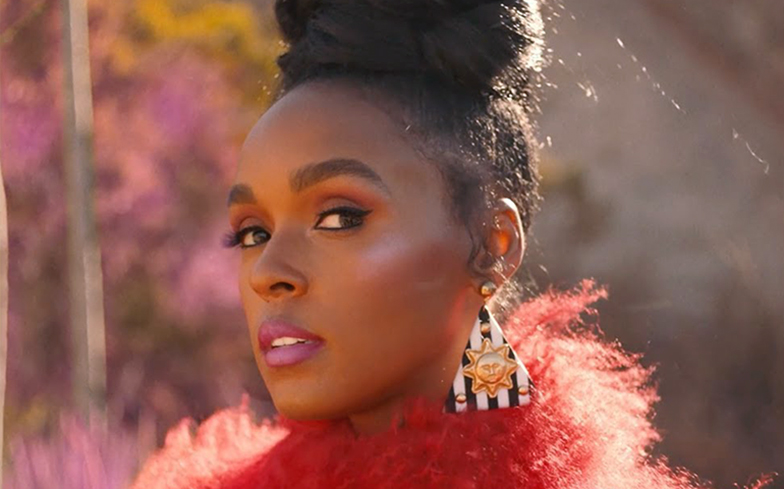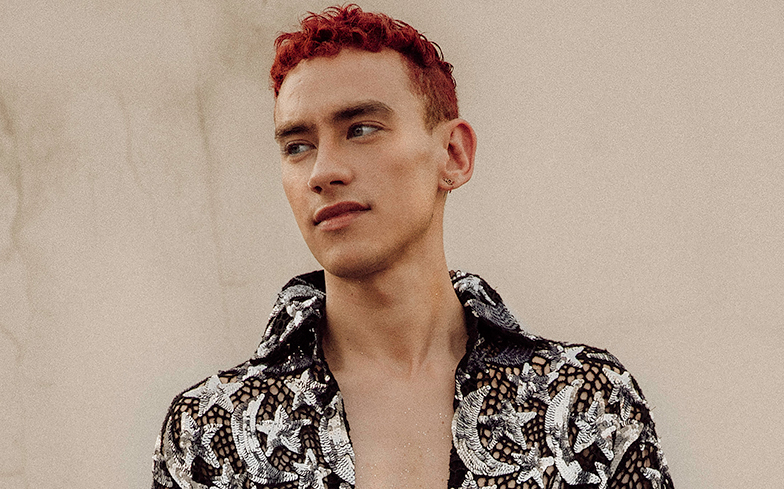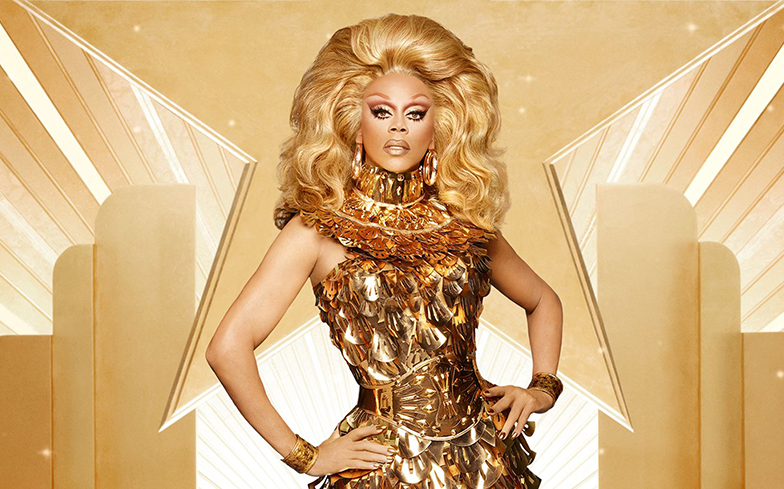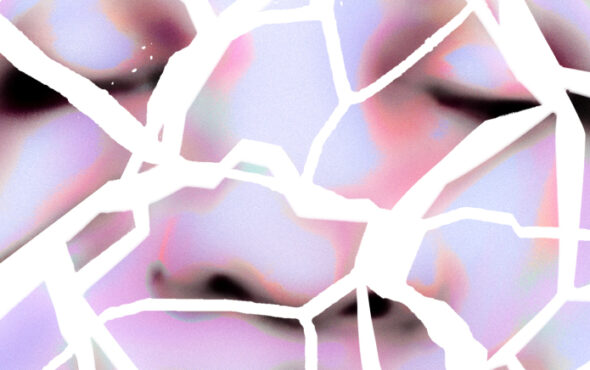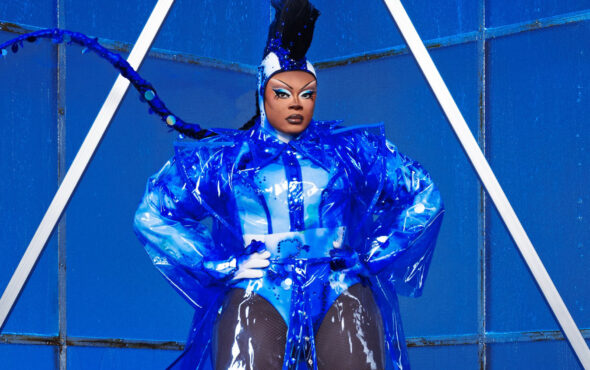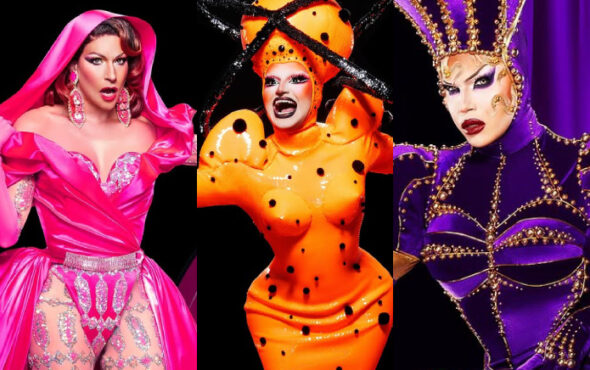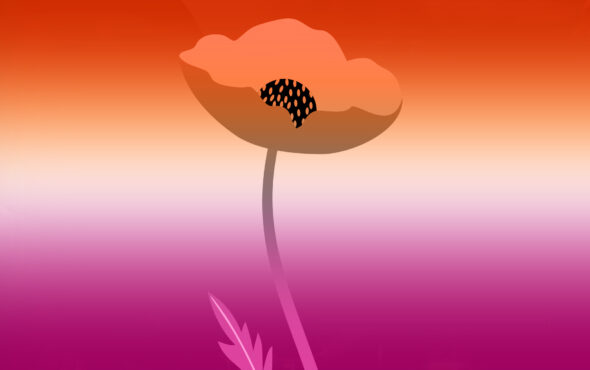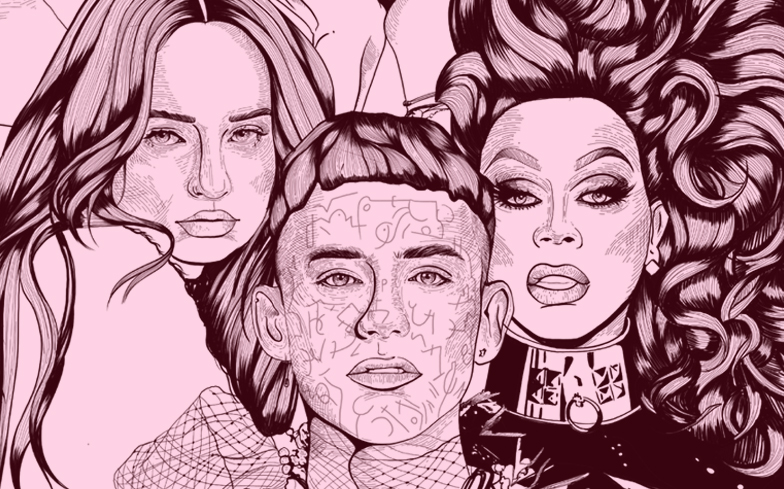
From Little Richard’s flaming piano playing in the ‘50s to Sam Smith calling himself a “dick monster” in a 2017 TV interview, pop music has always been queer.
At times, the number of LGBTQ artists claiming space in the mainstream has been greater than others: imagine tuning into British music show Top of the Pops in the early ‘80s and seeing performances from artists as conspicuously queer as Culture Club’s Boy George, Soft Cell’s Marc Almond and Dead or Alive’s Pete Burns. Legendary drag queen Divine even made it onto the show in 1984, lip-syncing to her gay disco hit You Think You’re a Man in a blonde beehive wig and skin-tight silver dress. Check out her still-mind-blowing performance on YouTube after reading this piece and your own wig will end up in a different postcode.
At other points in pop history, LGBTQ artists have enjoyed less visibility. Look up the UK’s 50 top-selling singles of 1995 and you’ll find some absolute bangers – Mariah Carey’s Fantasy, Celine Dion’s Think Twice, TLC’s Waterfalls – but a grand total of one song by an act with an obvious queer presence: Heaven for Everyone by Queen, whose frontman Freddie Mercury had died of complications arising from AIDS five years earlier.
The state of play for LGBTQ artists in 2019 feels a little more complicated. As last year’s #20GAYTEEN movement trumpeted, we now have a proper squad of queer pop stars to get behind: Janelle Monáe, Hayley Kiyoko, Troye Sivan, MNEK, SOPHIE, Christine and the Queens, Brockhampton, Anne-Marie and Years & Years all released critically-acclaimed albums in 2018. However, only the last two acts on that list scored a mainstream hit single – the sort of song you’d hear on Love Island or in All Bar One. Janelle Monáe’s inability to land a crossover smash is especially disappointing: fans and music critics have been hailing her as a superstar for years, but aside from 2011’s feature on Fun’s We Are Young, she’s never climbed higher than number 74 on the UK singles chart or number 79 on the US Billboard Hot 100.
In fairness, an alternative pop artist like Christine and the Queens isn’t really aiming for a place on commercial radio playlists alongside Clean Bandit and Little Mix (much as those playlists would benefit from a song as empathetic as Christine’s 5 Dollars, an electro bop about a sex worker). And Troye Sivan has since cracked the UK top ten with this year’s I’m So Tired, a slinky collaboration with fellow singer-songwriter Lauv. But the sneaking sense that there’s a kind of “rainbow ceiling” for LGBTQ artists – or at least some of them – remains hard to shake off.
The throb of controversy that greeted this year’s choice of Manchester Pride headliner seems to illuminate this rainbow ceiling. No one denies that Ariana Grande has been a valuable ally to the global LGBTQ community and a source of strength to the people of Manchester following the senseless terror attack of May 2017. And since her Pride appearance was confirmed, she’s clarified her own sexuality by saying she doesn’t “feel the need” to label herself.
But when Grande’s headline set was announced in February, along with a steep rise in ticket prices, many Pride regulars expressed disappointment that top billing at another LGBTQ event had been given to an (ostensibly) heterosexual artist. Sharing his thoughts on Twitter, Olly Alexander of Years & Years wrote: “I’d love to see more LGBT+ headliners across all bills, [but] the reality is line-ups are a mix of artists depending on their availability and the need to sell tickets. Prides normally raise money so they can put on their events and donate to various (usually local) causes.”
Alexander added: “In the case of Manchester Pride – Ariana has shown more than most that she cares about us and loves Manchester. Does that mean we shouldn’t try harder to celebrate all the amazing queer talent? No! But – can’t stress this enough – if more people listened to and supported LGBT+ artists – they’d get more slots.”
Alexander is patently right: we’ll see more queer artists in prominent slots at Pride events when more queer artists are racking up big numbers on Spotify. But what if the music industry doesn’t really want to help queer artists reach their full potential? In recent years, Alexander and Troye Sivan have shown that being openly gay is no impediment to building a large female fanbase, disproving the old boyband manager’s theory that a heartthrob loses his appeal when he becomes “unattainable”. Still, it’s very probable that some music industry executives remain intimidated by the idea of trying to market a non-heterosexual artist – if only because they’ve never had to do it before. Indeed, Alexander has revealed that he was advised not to talk about his sexuality soon after Years & Years signed their record deal. He’s also expressed doubts that industry pressure to stay in the closet to protect record sales no longer exists. “It’s undeniable that some artists who aren’t straight are hugely successful now, so I think [that idea] must have been dispelled to a certain extent,” he said last year. “But I just know there are people who are hiding their sexuality, so it’s still not gone completely, you know.”
And it’s no shock to discover that behind-the-scenes resistance can heighten if an artist belongs to more than one minority group. “I can’t speak for everybody’s experience, but I do think it’s a lot easier if you’re just ‘one thing’,” gay British-Pakistani musician Leo Kalyan told Gay Times last year. “It gets hard in this industry if you are queer and of colour.”
At the same time, we shouldn’t ignore glimmers of progress. When Sam Smith came out as non-binary in March, telling Jameela Jamil in an Instagram interview “I’m not male or female, I think I flow somewhere in between – it’s all on the spectrum,” it felt like a landmark moment. No one had stopped Smith from speaking freely about his gender identity, and he looked thoroughly comfortable doing so. The media then reported on what he said in a (mostly) matter-of-fact and sensitive way. Then again, Smith benefits from the power and profile that exceptional success in the music industry brings. It’s hard not to wonder: if he were a brand new artist without an Oscar and two number one albums to his name, would he have been advised to keep quiet in case his gender identity made things “complicated”?
The rainbow ceiling seems to loom especially low in the world of “drag-pop”. Given the incredible global success of RuPaul’s Drag Race, it’s surprising at best that none of its contestants has become a crossover pop star. Adore Delano’s 2014 debut album Till Death Do Us Party peaked at a very creditable number 59 on the US albums chart; Trixie Mattel can sell out decent-sized music venues and make a dent on the indie charts; and Courtney Act competed to become Australia’s 2019 Eurovision entrant. But none of the Drag Race queens has scored a mainstream hit to match RuPaul’s 1992 banger Supermodel (You Better Work) or Divine’s 1984 anthem You Think You’re A Man. As the TV show becomes ever more popular, and more of its contestants become successful international touring acts, this is starting to feel like a collective missed opportunity.
Sure, you can expect to hear RuPaul tunes like Kitty Girl and Sissy That Walk at any queer or mixed pop night in 2019, but Drag Race queens don’t get played on the radio. Many queens see recording a single as an extension of their brand rather than end in itself because their fattest pay cheques are going to come from the international drag circuit, not from Spotify royalties. Because of this, their music tends to target the existing Drag Race fan-base rather than aiming for a wider audience: Trinity the Tuck’s album is knowingly titled Plastic; Monique Heart dropped an entirely self-referential song called Brown Cow Stunning. Who can blame them for sticking to a tried and tested formula? There’s simply no precedent for a Drag Race queen being welcomed heels and all into the world of mainstream pop – can you see Courtney Act featuring on a Calvin Harris banger any time soon?
So at the moment, Drag Race queens make their biggest impact in the music world as glamorous accessories for mainstream pop stars. Courtney Act, Alaska and Willam appear in Little Mix’s Power video. Shangela can be heard briefly on Ariana Grande’s Thank U, Next album. Madonna’s rumoured to have recruited Monét X Change and others for her comeback campaign. Visibility is always an important first step, and perhaps these high-profile cameos are a sign that the Drag Race family is finally getting closer to slaying the pop charts.
And let’s remember that some of 2019’s most hotly-tipped artists are queer and proud. German pop singer Kim Petras, who’s trans, has toured Australia with Rita Ora this year and amassed nearly two million monthly listeners on Spotify. Japanese-British artist Rina Sawayama has been called “the future of pop” and uses her music to spotlight LGBTQ talent and explore her own queer identity.
Discussing her dazzling music video for Cherry, she told Billboard last year: “It was an all-queer POC cast. Literally everyone on the creative team and on set was queer, so it was such a celebration.” Brooklyn-based singer-songwriter King Princess, who’s signed to Mark Ronson’s label, has already been hailed as a “queer icon”. She recently spoke about lacking an LGBTQ role model in music when she was growing up. “We didn’t really have access to big gay pop stars,” she told the BBC. “I have people that I adore and love, who taught me it was OK to be gay, but they weren’t gay artists.”
Happily, today’s young queer pop fans won’t have the same problem. But we shouldn’t forget about LGBTQ artists from the past who’ve helped to make the careers of Olly Alexander, Troye Sivan and the rest a little easier. After George Michael effectively came out in 1998 by being arrested for “engaging in a lewd act” in a Beverly Hills public restroom, he refused to let the media shame him for being gay. He spoke unapologetically about cruising on Richard and Judy’s daytime chat show, and used his music to make a point. “Don’t let them use my life to put your future down,” he sang on 2006’s An Easier Affair, addressing his younger queer fans. “Don’t let them tell you that happiness can’t be found.” Michael’s courage was incredibly inspiring, and because of it, no artist today will have to face quite so much scrutiny regarding their sexuality.
Another sign of progress is the arrival of Pride in Music, a non-profit initiative bringing together members of the LGBTQ community working in the UK record industry. It’s a sector that has always relied on queer talent behind-the-scenes, but this is the first time that LGBTQ managers, promoters, PRs, writers and executives have had their own organisation. Launched in January of this year, Pride in Music says it “aims to provide a support network to break down stereotypes, to work as an education service to employers and staff, and [to act] as an entry point to the industry for underprivileged youth”. It also wants to “provide peer mentoring, networking, and an industry-wide social group to help those who may struggle with the anxieties and stigmas that generally arise”.
Hearteningly, Pride in Music has already made an impact by partnering with London’s Mighty Hoopla festival to offer an emerging LGBTQ artist a slot on the 2019 bill. It’s gone to the thoroughly deserving Leo Kalyan, who sings affectingly about reconciling his British Muslim roots with his queer sexuality on the beautiful electro bop Fucked Up.
So overall, there’s definitely plenty to celebrate when we talk about LGBTQ artists in music in 2019. But while we toast the progress that’s already been made, we should also steel ourselves for future battles. When I interviewed Olly Alexander for music magazine NME last November, he told me: “I still want to see more queer artists starring in their own big-budget music videos, selling loads of albums, making it into the charts. Not every artist wants those things, of course, but I think mainstream music is still pretty heterosexual despite there being so many queer artists out there making amazing music.”
The starting point? Engaging with the amazing music made by the fantastic queer artists celebrated in issue 495 of GAY TIMES.
